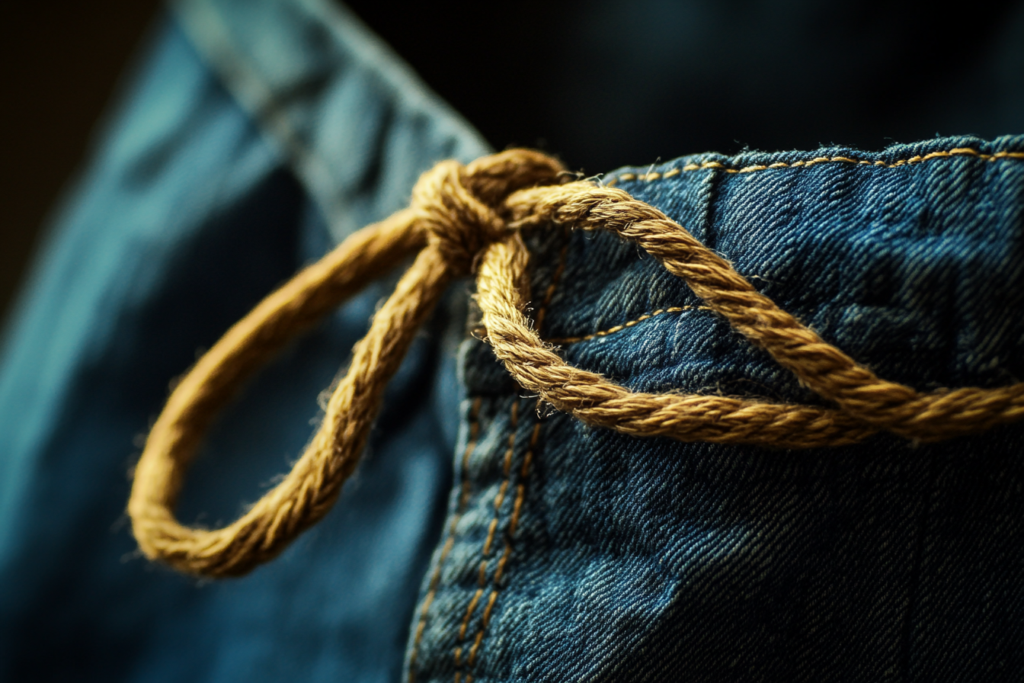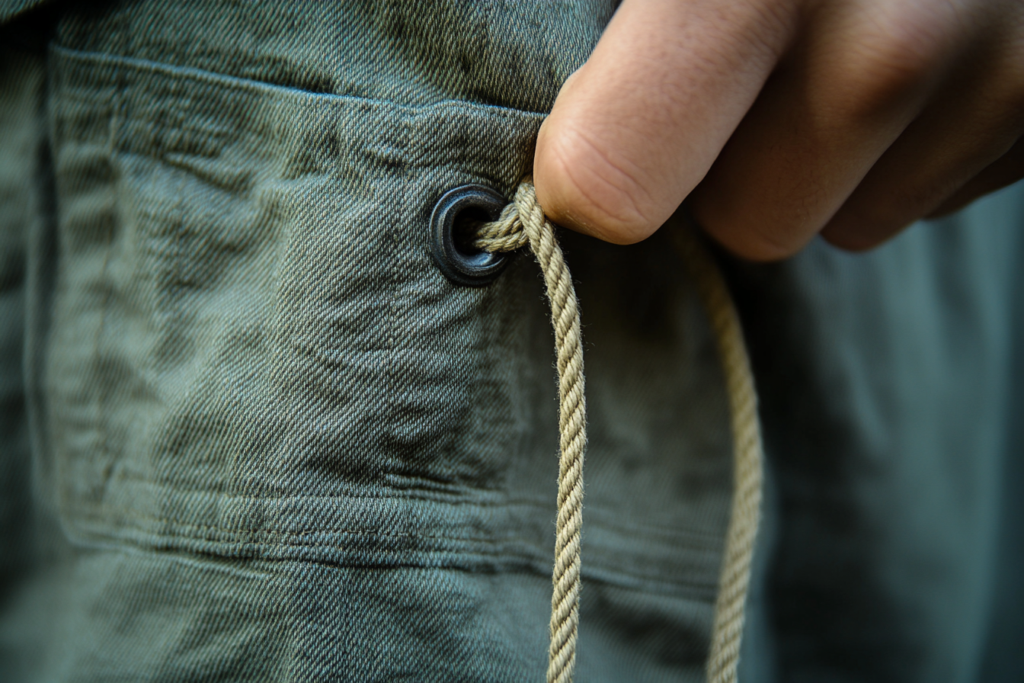Introduction: What is a Drawcord?
A drawcord is a cord or string inserted into a garment, typically at the waist, sleeve hem, or neckline, that allows the wearer to adjust the fit of the garment. It is commonly used to cinch or shape clothing for a more tailored and flattering silhouette. Drawcords are often seen in casual wear, sportswear, and outerwear, where functionality and adjustability are key.
The drawcord mechanism works by threading the cord through a casing or channel along the edge of the garment, and then pulling the cord tight to achieve the desired shape. This allows the wearer to customize the fit to their liking, making the garment more comfortable and practical for different body types or preferences.


Common Uses of Drawcords
- Waistline Adjustments:
- One of the most common uses of a drawcord is at the waistline of pants, shorts, or dresses. By pulling the cord, the wearer can adjust the tightness around the waist, ensuring a snug fit without the need for buttons or zippers. This is particularly useful in activewear or relaxed-fit clothing, where comfort and flexibility are important.
- Neckline Adjustments:
- Drawcords are also used in the neckline of hoodies, jackets, or blouses. A drawcord in the neckline allows the wearer to adjust the opening of the garment, providing extra warmth or coverage when needed. It’s often found in hooded sweatshirts and jackets, where it helps adjust the fit around the neck for comfort and style.
- Sleeve Hem Adjustments:
- In jackets, sweatshirts, and other outerwear, drawcords are frequently inserted into the sleeve hems. This feature enables the wearer to tighten the sleeves, preventing cold air from entering and ensuring a secure fit. Drawcords at the sleeve hem also help create a more streamlined look, especially in sporty or utilitarian styles.
- Pockets and Hems:
- Some garments incorporate drawcords into the pockets or hemline to offer additional shaping or to keep the design secure. This is often seen in outdoor gear, like windbreakers or parkas, where the added adjustability enhances the garment’s performance.
Benefits of Using a Drawcord in Garments
- Improved Fit:
- A drawcord allows for an adjustable fit that can conform to the wearer’s body shape. This is especially useful for garments that are meant to be worn in various activities or situations, as it gives the wearer flexibility to customize the fit for comfort or style.
- Versatility:
- The presence of a drawcord makes the garment more versatile, offering different styling options depending on how tightly or loosely it’s adjusted. For example, a drawcord at the waist can be cinched for a more tailored look or loosened for a relaxed, flowing silhouette.
- Functional Design:
- A drawcord enhances the garment’s functionality by allowing the wearer to adjust the garment to their specific needs. In jackets, for example, a drawcord around the waist or sleeve hem can help trap warmth in cold weather, making it an essential feature in outerwear.
- Casual and Sporty Appeal:
- Drawcords add a casual and sporty element to a garment, making them popular in activewear, athleisure, and outdoor apparel. This design feature brings a laid-back yet functional vibe to the overall look of the garment.
Drawcords in Different Types of Garments
- Hoodies and Sweatshirts:
- Hoodies and sweatshirts often feature drawcords in the hood or neck area to adjust the opening for warmth or comfort. In some cases, there may also be a drawcord at the waistline to adjust the fit and create a more tailored silhouette.
- Outdoor Jackets:
- In outdoor jackets, such as windbreakers or rain jackets, drawcords are commonly found at the waist and sleeve hems to trap warmth or adjust the fit. These garments are designed for performance and practicality, making the inclusion of drawcords essential for achieving the best fit and functionality.
- Pants and Shorts:
- Activewear and casual pants often have drawcords at the waist to provide an adjustable fit. This feature is commonly seen in joggers, sweatpants, and even shorts, allowing for easy customization based on the wearer’s body shape or activity.
- Dresses and Skirts:
- Some dresses and skirts feature drawcords at the waist or hemline to provide shape and adjustability. This design is especially popular in boho or casual styles, where a relaxed, flowing look can be accentuated with a drawcord.
How to Care for Drawcord Garments
- Washing:
- Garments with drawcords should be washed with care to avoid damage. It’s recommended to tie the drawcords before washing to prevent them from getting caught or tangled. Always check the garment’s care label for specific instructions on how to wash it properly.
- Drying:
- When drying drawcord garments, it’s best to hang them or use a low-heat dryer setting. Avoid pulling on the drawcords during drying to prevent stretching or fraying.
- Storage:
- Store garments with drawcords in a way that avoids excessive tension on the cords. Hanging them neatly will help preserve the elasticity and functionality of the drawcord.
Conclusion: The Practicality of Drawcords in Garment Design
Drawcords are a practical and functional design feature in many garments, allowing for a customizable fit and improved comfort. Whether adjusting the waistline, sleeve hem, or neckline, drawcords provide versatility and enhance the wearer’s ability to tailor their clothing to their specific needs. From casual wear to performance gear, drawcords continue to be an essential element in modern garment design, offering both style and function.



